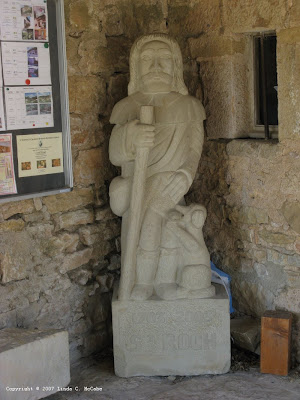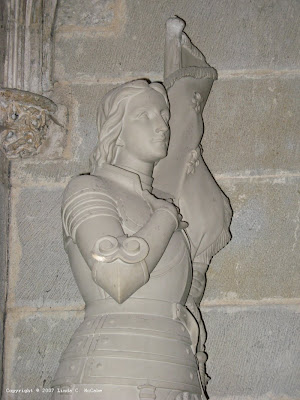Time for another massively long travel post filled with photography and anecdotes.

One of my favorite stories about my trip to France deals with our visit to the village of Bruniquel.
While plotting out locations for my novel I had a keen eye for those areas that were historically credible sites, but I had to make a few exceptions out of plot necessities. As I scanned the towns near Montauban in the
Michelin Green Guide for the Languedoc Roussillon Tarn Gorges area, I noticed the listing for Bruniquel where
Gregory of Tours mentioned this village in his History of the Franks regarding Queen Brunhilda. (The French name is Brunehaut, and in deference to townspeople of Bruniquel I shall use their preferred spelling unless I am quoting from a source that uses a different spelling.)
Brunehaut was a Visigothic princess (the daughter of King Athanagild) and married Sigebert, king of Austrasia and a grandson of Clovis.
The town of Bruniquel is named after Brunehaut who is credited for the town's founding.
I had read some about Bruniquel before our trip and had viewed
the town's website, but I was unsure of whether or not there was anything still standing that dated back to the time period of Charlemagne (8th and 9th centuries) or even Brunehaut (6th and 7th centuries.)
Upon arriving at this hilltop village we went directly to the Tourist Office. I wanted to know whether or not there was any buildings or fortifications or anything that I could view that dated back to the time of Brunehaut. The office was staffed with one employee and as I entered I saw there were several other tourists.
I waited my turn to ask questions.
Then there was an elderly gentleman who began a conversation with the official. I did not understand much of what was being said, but I recognized that this was not going to be over quickly. The only way that I was going to be able to talk with the employee would be to interrupt and that would not go over well.
I also was unsure if the employee spoke any English.
I did not want to interrupt a conversation and speak in halting French to ask my questions. I thought that would have been the height of rudeness, and so rather than wait for what might have been fifteen minutes or so, I left the office and decided to just make my way to the top of the village to the castles.
Yes, the plural is correct. Castles.
There was a family dispute and this brought about competing castles built on the same site. And you think you have "issues" with your family or next door neighbors!
At the entrance to the village is a sign depicting an aerial view of those castles. Here is a photograph of that sign. It looks as though the town is on the river, but it is deceiving because this is another strategic hilltop town that overlooks a river.
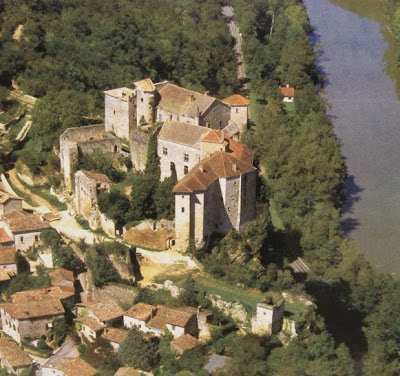
The next photograph is of the history of the town written in three languages.
Pardon the shadow of the camera hand, but these pictures were taken in the afternoon and nothing could be done to eliminate some shadows appearing.

Here is a monument found at the base of the town across the road from the Tourist office. It is in commemoration of those who gave their lives in World War I and II and stands in front of the church.

We made our way up the narrow streets and continued to marvel at the beauty of the stone used in the town to create buildings that have lasted for centuries.

Once we were at the top of the hill we had to walk around the fortifications surrounding the castles until we could find the entrance. I was struck by the drama of a tree and other foliage growing over these walls as if Nature was trying to reclaim the area from Man.

Here is another view from outside the walls where vegetation has been allowed to grow without being cut down.

Here is a wall with arrow slits and the outside of one of the castles.
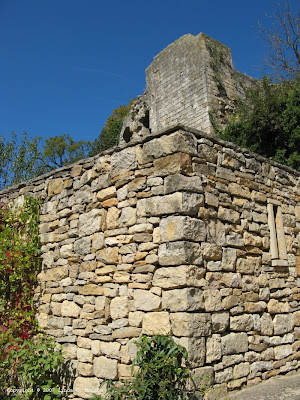
Here is a view of the Aveyron River from outside the village, but outside the castles.

Once inside the castle, we paid our entrance fee and were asked if we wanted a guided tour.
I then said, "
Anglais, s'il vous plaît?"The woman shook her head sadly and replied, "No, because my English is not that good."
I told her (in my best French) that I was writing a novel based on the legends of Charlemagne and was interested in anything before that time. I also mentioned that I wanted to know if anything stood that dated back to the time of Brunehaut.
As I mentioned Brunehaut's name, the woman's smile grew broader. The town is proud of this notorious woman from history.
She brought out an English language map of the site as well as a paper detailing its history, and suggested that after our tour that we should visit the town's museum the
Maison Payrol.
I had not planned on going there because the description in the Michelin guide did not make it seem as if there would be much of interest to my time period. I thanked her, and then left to explore the castles.
After having been in
Paris and
Carcassonne where most of the historical sites were renovated, as well as
Guédelon where a castle was under construction, I was a bit unprepared to see a site that had not been renovated. There were places that looked in dire need of repair.
Let us start with an ancient bread oven.

The glow is actually sunlight and not due to any red hot embers.
As we stepped outside we saw the remains of old domestic buildings.

Inside the shed is something for my fellow wine lovers: an old wine press. The better to squeeze you with my dear.
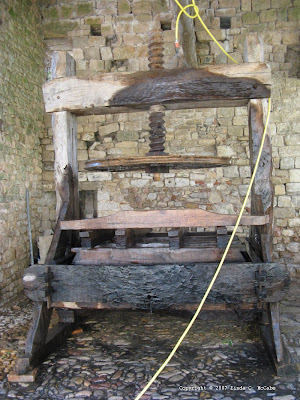
Here we get closer to what was labelled as the
Salle des Chevaliers (or Knights Room) from the 13th Century.
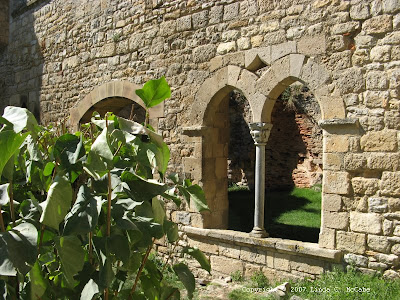
Inside was a ruined fireplace and hearth.

Here is a view into the courtyard and you can see one of the castles in the background. If you notice, the pillars are decorated with fantastic animals.
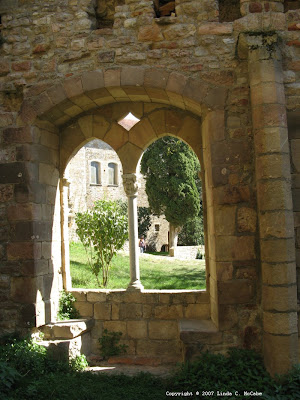
Here is a close up of one pillar.

I think it might be depicting a griffin due to the wings, but the facial features look more like that of a donkey than a bird, however the legs look distinctly avian-like. Even the hind legs.
Has anyone ever heard of a four legged bird? Even the fantastical beasts?
Either way, when I zoom in and analyze the picture it appears that the creature depicted is male.
Here's a view of another pillar with animals.

I think it is of a monkey standing on the back of something with legs bent in unnatural angles.
I do not know what the creature on the left is, but it appears to have four legs, feathers and male.
Any medieval bestiary experts out there who can tell me what kind of beasts they think are depicted on these pillars?
Moving along, here is a sign showing the outlines of the various structures within the confines of the fortified walls as well as a brief history.

There is a square in the center which is identified as the Keep or the Donjon.
Here is the sign outside of that structure denoting that it was named after Queen Brunehaut even though it was constructed centuries after her death.
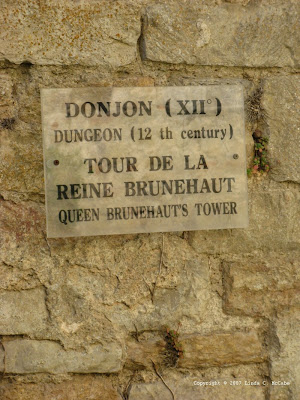
From the inside of the Donjon looking up.

The Keep is on the left hand side of this picture and on the right is the outside of the New castle and in the center is a tower from the old castle.

Here is a better picture of the old castle. It appears to be in pretty good shape from the outside.
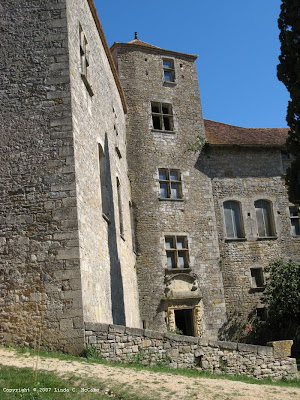
Ah, but the inside is not as pretty. I am not altogether sure what this thing was used for, but it is rusty and looks decrepit.
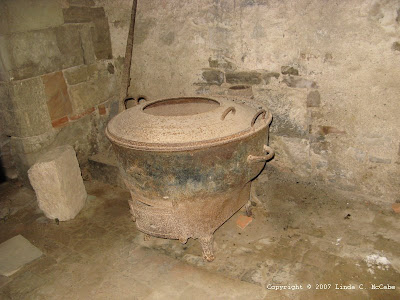
Here is another area that does not look inviting to me.

The castles in Bruniquel are used by the community to showcase artwork. Here you can see photographs displayed that were part of an exhibit of "ghost photography."
If you look closely you might be able to see spirits.
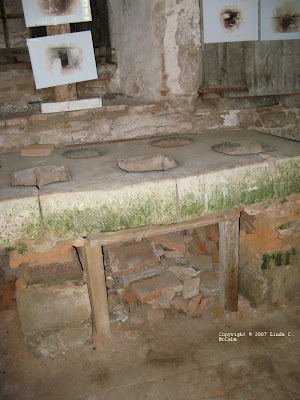
Into another portion of the castle there was a mural on crumbling plaster.

From the vantage point of an upstairs window you can look down upon the
Salle des Chevaliers and the roof of the shed that held the wine press
.
From another window facing a different direction you can look down upon the Aveyron River.

I believe that the following pictures were taken from the "new castle." You can see that the floor for the second story has been removed. Otherwise why else would there be a fireplace in mid air?
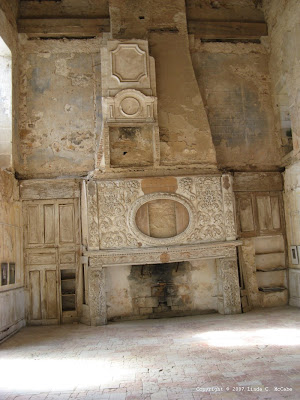
Here is another floating fireplace and the post holes from the missing flooring are evident. You can also see artwork hung by a pipe and chains under the hearth with care.

After touring the castles I wanted to ask a few more questions of the woman who I had spoken with earlier. I was disappointed when I saw someone else at her window.
We then walked through the streets of Bruniquel to find
La Maison Payrol and saw this beautiful house along the way.

I was surprised when we arrived at the museum to find that the woman I had wanted to ask a few more questions was there. She was waiting for us.
She took me upstairs and showed some handwritten notes about Queen Brunehaut.
I was told about the road outside Bruniquel was known as "La Voie Romaine et le Chemin de la
Reine" and she thought it might be from Cahors to possibly Albi.
For those who are unaware of the history of Queen Brunehaut, it is one of revenge, violence, fratricide, repeated assassination attempts and ultimately a tragic death.
Brunehaut as mentioned previously was the daughter of King Athanagild of the Visigoths and married Sigebert who was king of Austrasia. Gregory of Tours described her as "a maiden beautiful in her person, lovely to look at, virtuous and wellbehaved, with good sense and a pleasant address."
She was so impressive that Sigebert's brother Chilperic, king of Nuestria, wanted to know if Brunehaut had a sister. He wanted someone just as beautiful and refined to be his queen. King Athanagild then sent his daughter Galsuenda to be married to Chilperic.
The problem was that in order for Chilperic to wed Galsuenda, he had to put away his previous wives. One of which was a woman named Fredegunde.
The marriage of Chilperic and Galsuenda did not last very long. It appears that she did not like his dalliances with other women and she wanted to go back to her father. That did not happen. Instead, she was found strangled and Chilperic was soon remarried to Fredegunde.
This led to a decades long feud between Brunehaut and Fredegunde.
Brunehaut was later awarded her sister's dowry since Galsuenda died an unnatural death.
And as to the cities, namely, Bordeaux, Limoges, Cahors, Lescar, and Cieutat, which it is well known that Galsuntha, lady Brunhilda's sister, acquired as dowry or morganegyba, that is, morning gift, when she came into Francia, and which lady Brunhilda is known to have acquired by the decision of the glorious lord king Gunthram (a third brother and king of Burgundy) and of the Franks when Chilperic and king Sigibert were still alive, it is agreed that the lady Brunhilda shall have as her property from today the city of Cahors with its lands and all its people, but the other cities named lord Gunthram shall hold while he lives... Gregory of Tours History of the Franks, Book Nine in the Twelfth year of King Childebert: 20
And this is where Bruniquel comes from because of the proximity to Cahors which is approximately 55 kilometers away.
A war was fought between the brothers Sigebert and Chilperic, and Sigebert died at the hands of assassins sent by his brother.
The widowed Brunehaut became regent for her son Childebert II who was only four at the time of his father's death. According to Gregory of Tours, King Chilperic kept Brunehaut in exile in Rouen at this time.
Chilperic was betrayed by his son Merovech who left his military detail to go to Brunehaut, who he then secretly married. The nephew marrying his uncle's widow was considered to be incestuous and Chilperic put an end to the marriage and forced his wayward son into a monestary and then a series of intrigues which resulted in Merovech asking someone to kill him lest he fall into his enemies' hands. Gregory of Tours wrote, "There were some at the time who said that Merovech's words, which we have just reported, were an invention of the queen (Fredegunda), and that Merovech had been secretly killed at her command."
Gregory of Tours documented plots and counterplots between Brunehaut and Fredegunde as well as plots and counterplots with other Frankish nobles, but alas Gregory died before he could chronicle the end of Queen Brunehaut's life.
She wound up being regent of Austrasia three times: first for her son Childebert II, second for her grandson Théodebert II, and later for her great-grandson Sigebert II.
Brunehaut is reputed to have built many churches over the years and fixed old Roman roads, but she also crossed many nobles and created enemies.
Even after Fredegunde's death, Brunehaut's archenemy still had a role to play. Fredegunde's son Clotaire exacted the downfall of his mother's nemesis.
Fearing Brunehaut's coming to power once again as regent on behalf of her great-grandson Sigebert II, Clotaire brought together a meeting of the nobles and he accused his aunt of heinous crimes. They sided with him and she was tortured and then put to death.
She died at the age of seventy nine.
Seventy nine.Just when you think that no one lived all that long in the middle ages, you find examples such as Charlemagne and Brunehaut living long and full lives.
I asked the
grande dame who was showing us the museum how Queen Brunehaut died because I had seen conflicting reports. I wanted to know if she had been drawn and quartered.
The lady shook her head vigorously. "No. She was dragged to her death on the back of a horse."
Which was the other version I had seen.
I then wanted to know where she was put to death.
Bruniquel.
And Normandy, as well as Brussels.
She laughed and I realized that Brunehaut's body had not been transported from one site to another and dragged again, it was that this story was so dramatic that multiple places wanted to claim the distinction of having been the site of her death.
Look again at this image from the top of the page and read the bottom lines if you can understand French.

En 613, CLOTAIRE II, le fils de FREDEGONDE, condamne BRUNEHAUT à périr attachée à la queue d’un cheval indompte.
La légende veut que ce supplice eut lieu à BRUNIQUEL, sur la <
>, à l’ouest du village.
--
My own translation:
In 613, Clotaire II, the son of Fredegonde, condemned Brunehaut to die by attaching her to the tail of a horse.
The legend is that the torture took place in Bruniquel on the red road west of the village.
--
I then suggested that there was another legend of the death happening in Paris, but she shook her head.
Upon arriving back home and I had time to referred to some of my notes that I realized why I thought Brunehaut might have died in Paris. I had read that in Robert Cole's A Traveler's History of Paris.
The chronicles relate that she was taken prisoner, 'reproached' with responsibility for the death of ten kings. She was then set on a camel for three days to be mocked and insulted by the army, after which she was tied to the tail of a horse 'which was lashed into a fury.' Soon all that remained of Brunhild was 'a shapeless mass of carrion,' as Thomas Okey described it with something less than delicacy. Tradition places the execution at the corner where Rue Saint-Honoré meets Rue de l'Arbre Sec. page 18
Here are two different depictions of Brunehaut being executed. The first makes her appear as if starch were applied quite liberally throughout her body.
Talk about stiff.
And the legs are disporportionately long as well. (Did she get put on the Rack first?)

 Grandes Chroniques de France, XIV°, Bibliothèque Nationale.
Grandes Chroniques de France, XIV°, Bibliothèque Nationale.
This next one shows more realism as well as drama. However, the body does not seem like it belongs to a seventy-nine year old woman.
 Histoire de France, by François GUIZOT 1875
Histoire de France, by François GUIZOT 1875
This tragic story of power, assassinations, and assassination plots as well as a brutal execution demonstrated to me the stark difference between historical reality of being in a royal family over the "prince and princess stories" fed to children as an idyllic life.
Think of the story of Brunehaut the former Visigothic princess the next time you see a little girl dressed up in a pink frilly Disney princess dress. Although I do not suggest you tell the girl the story of Brunehaut and Fredegonde, just keep that as your own inner monologue.
In retrospect, I wish I had asked to take a picture of the woman who was so kind to me.
Her grasp of English was better than my grasp of French and we communicated by talking as much as we could in each other's language. It is when either of us could not come up with words we needed that we resorted to using our own own tongues. Somehow in the middle we were able to have a meaningful conversation.
She had finished her day working at the castles and waited for me at the museum so that she could share the history of her village. That is a kindness that I shall remember for years.
The time spent in Bruniquel is one of my fondest memories of my trip to France and it is one that I mention when asked about the hospitality we received by the French people.
